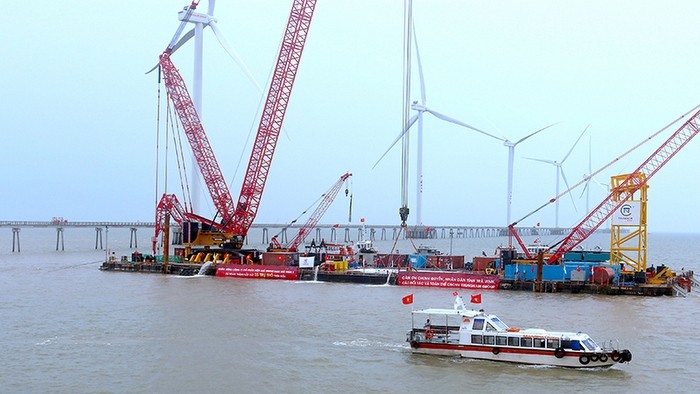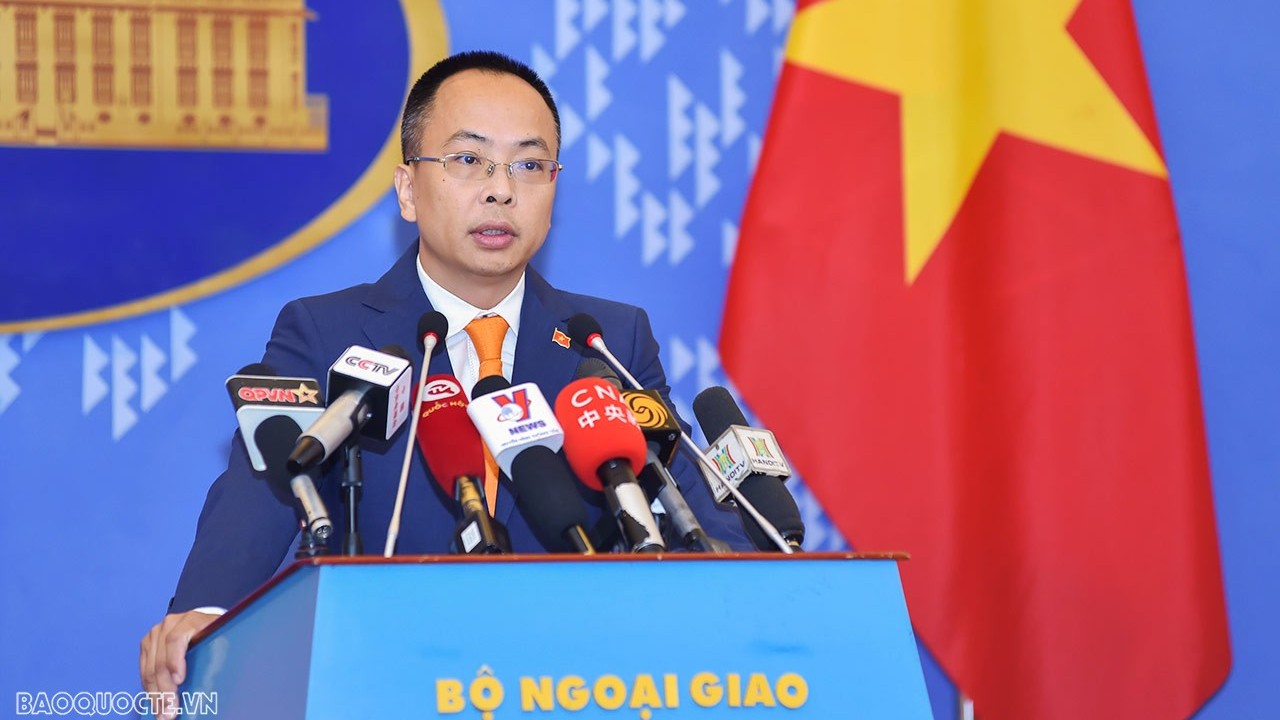
Mekong River Delta region enhances sustainable development of clean energy
Latest
 |
| Wind turbines are installed at Dong Hai 1 Wind Power Project in Tra Vinh Province. (Photo: Minh Khoi) Font Size: | |
Projects full of sun and wind
During these days, the coastal commune of Dong Hai in Duyen Hai District, Tra Vinh Province, is bustling with thousands of workers and engineers who are busy completing the final stages so that the Dong Hai 1 Wind Power Plant project can generate ‘wind power’ for the national grid.
The project, which has received total investment of nearly 5 trillion VND, was launched in 2020 and became the first offshore wind power plant in Tra Vinh. In order to keep up with the schedule, Trung Nam Group has mobilised more than ten thousand engineers and workers to serve the construction at sea. As a result, by October 2021, all 25 wind turbines of the project have been completed, with a total capacity of 100 MW. Once it is operated, Dong Hai 1 Wind Power project will add 330 million kWh of “clean energy” to the national grid per year.
Following the decision to “reopen” economic activities, the projects in the Mekong Delta have become busy and bustling. In the east coastal region of Ngoc Hien District, Ca Mau Province, thousands of workers and engineers have been hard at work on wind power projects. Director of Ca Mau Provincial Department of Industry and Trade Nguyen Van Do said that with the current urgent progress, an additional 70 MW of wind power is expected to be put into commercial operation in the province by the end of 2021, increasing the total capacity of wind power projects which were officially put into operation in the province this year to 170MW.
In the coastal area of Hoa Binh District (Bac Lieu Province), following more than two years of urgent construction, nine turbines of the first phase of Kosy Wind Power Plant, with investment and operation by Kosy Joint Stock Company, a member of Kosy Group, was also completed to connect to the national grid.
According to Chairman of Bac Lieu Provincial People's Committee Pham Van Thieu, 8 out of 9 wind power plants in the locality will have been completed and put into commercial operation by the end of December, with a total capacity of 469.2 MW, the largest in the Mekong Delta region and the third largest in the country.
Specifically, the province had six offshore wind power projects (with a capacity of 349.2 MW) and two inland ones (with a capacity of 120 MW). Its annual wind power output reached more than 1.4 billion kWh, contributing nearly 300 billion VND per year to the province’s budget.
Taking advantage of natural conditions, many localities in the Mekong Delta have been “rolling out the red carpet” to attract investment for the development of renewable energy projects, contributing to solving the problem of energy security and creating a breakthrough for their socio-economic development.
This is also the reason why 275 hectares of the vast and barren land in An Hao Commune, Tinh Bien District, which is located at the foot of Cam Mountain – the highest of That Son range in An Giang Province, has become host to solar power fields.
With a total capacity of 210 MWp and investment of over 6 trillion VND, the power field of Sao Mai Group generated nearly 400 million kWh of electricity for the national grid.
According to An Giang Provincial People’s Committee Nguyen Thanh Binh, since Sao Mai Group invested in the solar power plant, the barren land in Bay Nui (Seven Mountains) area has undergone great changes.
In addition to creating thousands of jobs for the locals, especially Khmer ethnic minority group, the solar power farm at the foot of Cam Mountain (Sao Mai Solar Farm) was constructed according to the model of a green farm in the middle of the meadow, creating a "push" for sustainable development of the green industry in combination with eco-tourism exploitation.
To make clean energy into a driving force for development
The Mekong River Delta has a coastline and islands with a length of about 700km and a marine exclusive economic zone of up to 360,000 km2. With strong coastal wind conditions, the potential for wind power can reach from 1,200 to 1,500 MW.
A recent study by the German Agency for International Cooperation (GIZ) also showed that the whole region received an average of 2,200-2,500 hours of sunshine per year, with more than 90% of the days in the year having received sunlight that was strong enough to operate the solar panels, with an average radiation of 1,387-1,534 kWh/kWp per year.
With the parameters from the above study, the total potential of solar power capacity in the Mekong River Delta region may reach up to 136,275MW, with an estimated electricity output of more than 216 billion kWh per year.
In addition, the potential from ocean waves, tidal energy, and abundant biomass energy from agricultural by-products of more than 23 million tonnes per year that the localities have not invested and exploited.
In recent years, many provinces in the Mekong Delta region have stepped up calling for investment to develop clean and renewable energy projects, especially Ca Mau Province with its 254-km coastline, large coastal alluvial area, and a fishing ground of more than 80,000 km2.
The Provincial Party Committee has identified one of three strategic breakthroughs for the 2020-2025 term that is strengthening investment promotion and prioritising to call on strategic investors with strong financial potential to invest in the fields of local strength, especially clean energy projects.
In order to realise the set target, since the preparation of the Provincial Party Congress for the 2020-2025 term, Ca Mau has laid a solid foundation by immediately implementing 16 wind power projects (with total capacity of 1,000 MW) that were approved in an electricity development plan.
That is also a potential for Ca Mau to collect a sustainable budget revenue of more than 1,000 billion VND per year as 1,000 MW of wind power is officially put into commercial operation, leading to the development of a series of industries, such as trade, eco-tourism and services in coastal areas.
According to Vice Chairman of Ca Mau Provincial People’s Committee Lam Van Bi, the province aims to add more 5,000 MW of wind power by 2030 and 11,000 MW by 2045. The locality has proposed the Prime Minister to soon consider and approve the deployment of 37 energy development projects, with total capacity of over 25,500 MW, until 2045, along with power grid projects and green hydrogen gas production plants that will guarantee the release of capacity for energy projects.
According to a survey of domestic and foreign investors, the potential for the development of inland and offshore wind power projects in Soc Trang province is equivalent to a capacity of more than 7,000 MW. Up to now, Soc Trang has had 20 wind power projects approved by the Prime Minister to the master plan with a total capacity of 1,435 MW.
The Provincial People’s Committee granted investment policy decisions for 16 projects of 1,095 MW. Thanks to the drastic action, 11 out of 16 wind power projects have commenced construction so far while four wind power plants are expected to be put into commercial operation by the end of 2021.
Soc Trang Provincial Party Committee Lam Van Mau noted that the province aims to provide sufficient energy with high quality to meet the needs of socio-economic development, especially in remote, isolated and coastal areas. The province will enhance the fast, efficient, and sustainable development of the energy industry in accordance with environmental protection.
In addition to the liquefied natural gas thermal power plant, which has a total capacity of 3,200 MW and total investment capital of 4 billion USD, Bac Lieu Province has been constructing nine wind power projects with a total capacity of 562 MW as well as proposed bringing its power sources of more than 9,000 MW to the next phase of the Power Plan VIII.
Vice Chairman of Tra Vinh Provincial People's Committee Nguyen Quynh Thien said the province has focused on the development of coastal industries, especially giving priority to the development of renewable energy sources. The locality’s wind power development plan to 2020, with a vision to 2030, has been approved by the Ministry of Industry and Trade, with total capacity of 1,608 MW.
The Provincial People’s Committee proposed the Ministry of Industry and Trade to consider and submit to the Prime Minister for his approval of adding 17 wind power projects with a total capacity of 2,400MW as well as a transformer station and a 500kV transmission line to the revised Power Plan VII. So far, 4 out of 17 projects, with a total capacity of 396 MW, have been approved.
In general, the localities in the Mekong Delta region have a great potential and a long-term roadmap to develop clean energy projects. However, in order to have a sustainable budget revenue, the power projects need to be integrated with other industries and fields of local strengths, especially green tourism and agriculture, creating green value and growth.























